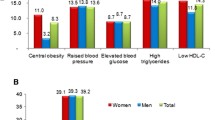Abstract
Sikkim has been reported to have the highest percentage of Diabetes Mellitus and Hypertension in the country. The study aimed to focus its precursor termed ‘Metabolic Syndrome’ (MetS) with special attention to its risk determinants as a measure to promote awareness in preventing the rise in number of these non communicable diseases in the state with only 6,10,577 inhabitants. Of 361 participants, 33.5% were diagnosed MetS as per the harmonized MetS criteria, 64.5% deemed non-MetS comprised of participants with “2 Risk”, “1 Risk” and “0 Risk” for MetS, however not enough (3 or more) to be categorized as MetS. A “large WC + elevated BP + raised FBS”; “large WC + elevated BP” and “large WC” were the different types of risk combinations found frequently in the “3 Risk”, “2 Risk” and “1 Risk” category respectively. MetS was most common among the females and highly found in 51–60 years of age. Ethnically “Bhutia/Lepcha/Tamang/Sherpa” were diagnosed with highest percentage of MetS followed by “Nepalese” and “Others”. The chief contributing factor to compose MetS in the female population was a large WC. We conclude, Diabetes and Hypertension are indeed prevailing in Sikkim and that the presence of either an increased waist circumference or an elevated blood pressure mandates a check for the remaining four risk factors for MetS, rendering worthwhile to keep an account of MetS risk types by stratification to comprehend the influence of socio-cultural and ethno-geographical factors in causing MetS.
Similar content being viewed by others
References
Alexander J. Sikkim reports highest number percent of diabetes, hypertension as per NPCDCS screening. pharmabiz.com. 2013. http://Pharmabiz.com. 12 Oct 2013.
World Health Organization (WHO). Deaths from NCDs http://www.who.int/gho/ncd/mortality/morbidity/en
Joshi SR. India—diabetes capital of the world: now heading towards hypertension. Japi.org. 2007. http://www.japi.org
Grundy S. Diagnosis and management of the Metabolic Syndrome: an American Heart Association/National Heart, Lung, and Blood Institute Scientific Statement. Circulation. 2005;112(17):2735–52.
Harding J, Shaw J, Peeters A, Cartensen B, Magliano D. Cancer risk among people with Type 1 and Type 2 Diabetes: disentangling true associations, detection bias, and reverse causation. Diabetes Care. 2014;38(2):264–70.
Wilson P. Metabolic Syndrome as a precursor of Cardiovascular Disease and Type 2 Diabetes Mellitus. Circulation. 2005;112(20):3066–72.
Isomaa B, Almgren P, Tuomi T, Forsen B, Lahti K, Nissen M, et al. Cardiovascular morbidity and mortality associated with the Metabolic Syndrome. Diabetes Care. 2001;24(4):683–9.
Alberti K, Zimmet P. Definition, diagnosis and classification of diabetes mellitus and its complications. Part 1: diagnosis and classification of diabetes mellitus. Provisional report of a WHO Consultation. Diabet Med. 1998;15(7):539–53.
Grundy S. Diagnosis and management of the Metabolic Syndrome: an American Heart Association/National Heart, Lung, and Blood Institute Scientific statement: executive summary. Circulation. 2005;112(17):e285–90.
Alberti K, Zimmet P, Shaw J. The metabolic syndrome—a new worldwide definition. Lancet. 2005;366(9491):1059–62.
Alberti K, Eckel R, Grundy S, Zimmet P, Cleeman J, Donato K, et al. Harmonizing the Metabolic Syndrome: a joint interim statement of the International Diabetes Federation Task Force on Epidemiology and Prevention; National Heart, Lung, and Blood Institute; American Heart Association; World Heart Federation; International Atherosclerosis Society; and International Association for the Study of Obesity. Circulation. 2009;120(16):1640–5.
Enas E, Chacko V, Pazhoor S, Chennikkara H, Devarapalli H. Dyslipidemia in South Asian patients. Curr Atheroscler Rep. 2007;9(5):367–74.
GeoHive—India population statistics. Geohive.com. http://www.geohive.com/cntry/india.aspx
Grundy SM. Metabolic Syndrome pandemic. Arterioscler Thromb Vasc Biol. 2008;28:629–36.
Aguilar M, Bhuket T, Torres S, Liu B, Wong R. Prevalence of the Metabolic Syndrome in the United States, 2003–2012. JAMA. 2015;313(19):1973.
Misra A, Vikram N. Insulin resistance syndrome (Metabolic Syndrome) and obesity in Asian Indians: evidence and implications. Nutrition. 2004;20(5):482–91.
Alberti K, Zimmet P, Shaw J. Metabolic Syndrome—a new world-wide definition. A consensus statement from the International Diabetes Federation. Diabet Med. 2006;23(5):469–80.
Pathania D, Bunger R, Bunger E, Mishra P, Arora A. An epidemiological study of Metabolic Syndrome in a rural area of Ambala district, Haryana. J Fam Community Med. 2014;21(2):130.
Sawant A, Mankeshwar R, Shah S, Raghavan R, Dhongde G, Raje H, et al. Prevalence of Metabolic Syndrome in Urban India. Cholesterol. 2011;2011:1–7.
Sarkar S, Das M, Mukhopadhyay B, Sekhar Chakraborty C, Majumder P. Prevalence of Metabolic Syndrome in two tribal populations of the sub-Himalayan region of India: ethnic and rural–urban differences. Am J Hum Biol. 2005;17(6):814–7.
Despres J. Abdominal obesity: the most prevalent cause of the Metabolic Syndrome and related cardiometabolic risk. Eur Heart J Suppl. 2006;8(Suppl B):B4–12.
Lee J, Pedley A, Hoffmann U, Massaro J, Fox C. Association of changes in abdominal fat quantity and quality with incident Cardiovascular Disease risk factors. J Am Coll Cardiol. 2016;68(14):1509–21.
Harvey R, Ferrier D. Biochemistry. Philadelphia: Wolters Kluwer Health/Lippincott Williams & Wilkins; 2011.
Ferrier D, Harvey R. Lippincott’s illustrated reviews: biochemistry. 5th ed. Philadelphia: Wolters Kluwer; 2011.
Roshni M. Metabolic Syndrome and the frequency of occurrence of its components in urban South Indian population. BJMMR. 2014;4(29):4855–67.
Acknowledgements
We would like to sincerely thank Indian Council of Medical Research (ICMR) for funding our research project [IEC/192/12-05(a)] on ‘Metabolic Syndrome’ (5/7/1099/2013-RCH) undertaken in the Department of Biochemistry—this study represents a section of the work.
Author information
Authors and Affiliations
Corresponding author
Ethics declarations
Conflict of interest
There is no conflict of interest.
Rights and permissions
About this article
Cite this article
Bhutia, R.D., Singh, T.A., Sherpa, M.L. et al. “Metabolic Syndrome and Its Risk Determinants in Sikkim”: A Glimpse from a Hospital Study. Ind J Clin Biochem 32, 480–486 (2017). https://doi.org/10.1007/s12291-017-0635-8
Received:
Accepted:
Published:
Issue Date:
DOI: https://doi.org/10.1007/s12291-017-0635-8




